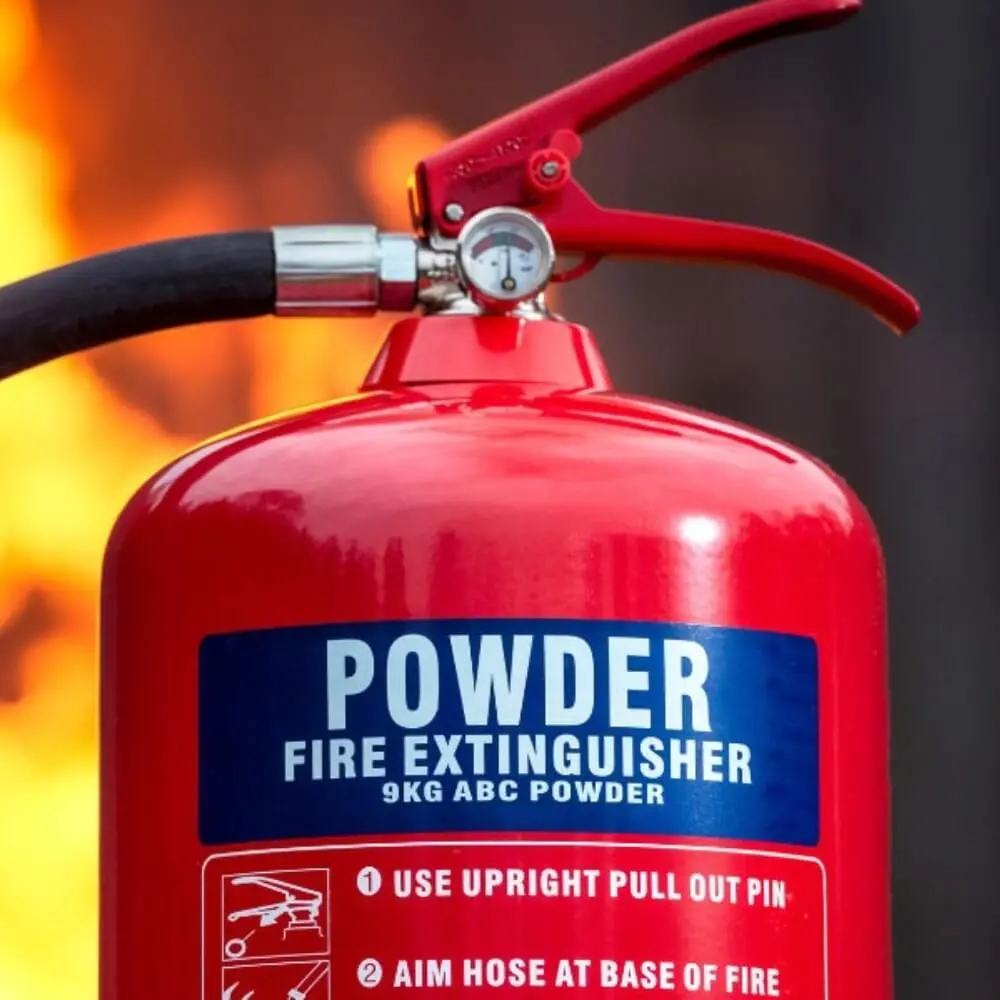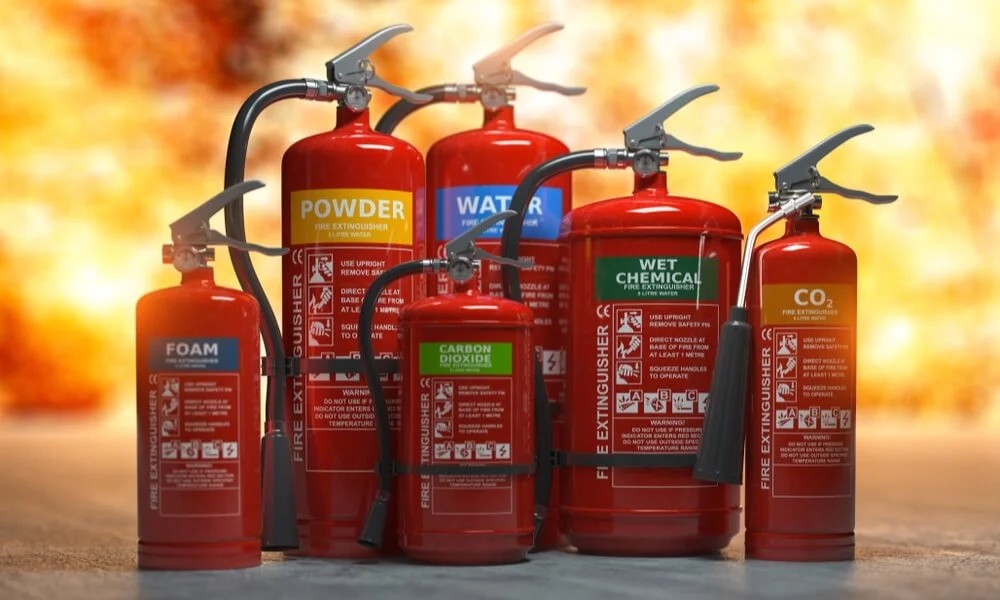When it comes to fire safety, knowledge is power. Fire extinguishers are critical lifesaving tools, but did you know that not all fire extinguishers are created equal? Each extinguisher is designed to tackle a specific type of fire, making it essential to understand their differences. This knowledge could mean the difference between effectively controlling and exacerbating a fire.
In this blog post, we’ll decode the color coding system used for fire extinguishers, delving into the unique role each type plays in fire safety. We’ll look at the five main extinguisher colors: Blue, Black, Cream, Red, and Yellow, and discuss what types of fires they’re designed to combat. Additionally, we will explore the historical reasons for the color changes in fire extinguishers and why these color codes are crucial for safety.
Understanding these codes is vital whether you’re a business owner, a safety officer, or a curious individual. By the end of this blog, you’ll have a solid grasp of fire extinguisher color codes and their meanings, empowering you to make informed decisions during a fire. Let’s get started, as every moment counts regarding fire safety!
Fire Extinguisher Colors Codes And Their Meanings
Fire extinguishers are coded with different colors to identify the type of fire they are designed to extinguish. These color codes are standardized to allow anyone to quickly and correctly choose the appropriate fire extinguisher in case of a fire.
The five main fire extinguishers in the UK are water, foam, dry powder, CO2, and wet chemical, each with a specific color. As of 1997, all fire extinguishers in the UK have a red body, but a colored band indicates their type.
Here is a summary of each type of extinguisher, the associated color code, and what kind of fires they are suitable for:
1. Blue (Dry Powder Extinguishers)

Dry powder extinguishers are versatile because they can be used on multiple types of fires. They are often known as ‘ABC’ extinguishers because they can tackle Class A (combustible materials such as wood and paper), Class B (flammable liquids like petrol or paint), and Class C (flammable gases like propane) fires. They work by coating the fuel with a thin layer of dust, separating the fuel from oxygen and interrupting the chemical reaction of the fire. They can also be used on electrical fires, but caution must be exercised as the powder can be easily inhaled in enclosed spaces, making cleanup challenging. A specialized dry powder extinguisher can also be used on flammable metals like magnesium or titanium.
2. Black (Carbon Dioxide (CO2) Extinguishers)

These extinguishers are ideal for electrical fires because they do not leave a residue that can damage sensitive equipment. CO2 extinguishers suffocate the fire by replacing the oxygen with CO2. They can also be used on Class B fires involving flammable liquids, but they’re ineffective against fires involving kitchen fires or flammable materials like wood, cardboard, etc. Due to the CO2 being very cold, they can also cause frostbite if mishandled.
3. Cream (Foam Extinguishers)

Foam extinguishers are primarily designed for Class B fires (those involving flammable liquids) but are also effective on Class A fires (those involving combustible materials). The foam forms a blanket over the burning surface, starving it of oxygen while cooling the material. Foam extinguishers are unsuitable for kitchen fires, fires involving flammable metals, or electrical fires.
4. Red (Water Extinguishers)

Water extinguishers are most effective against Class A fires (those involving combustible materials like wood, paper, and textiles). They work by cooling the burning material and reducing its temperature below the ignition point. This extinguisher type is unsuitable for kitchen, electrical, or fires involving flammable liquids or gases. Also, as water conducts electricity, using a water extinguisher on an electrical fire could cause electrocution.
5. Yellow (Wet Chemical Extinguishers)

Wet chemical extinguishers are designed for Class F fires (fires involving cooking oils or fats). The wet chemical rapidly knocks the flames out, cools the burning oil, and chemically reacts to form a soap-like solution, sealing the surface and preventing re-ignition. They can also be used on Class A fires (combustible materials) but are unsuitable for electrical fires or fires involving flammable metals, liquids, or gases.
In addition to these main types, there are other specialized fire extinguishers for specific circumstances, like metal fire extinguishers for fires involving flammable metals. Please note that the standards and color codes may vary from country to country, and you must be familiar with your local regulations.
Why Did The Fire Extinguisher Colour Change?
Before 1997, the entire body of a fire extinguisher was painted with a color corresponding to its type. For example, water extinguishers were red, foam extinguishers were cream, dry powder extinguishers were blue, and so on.
However, in 1997, the standard changed. This change was due to the British and European Standard BS EN3. Since then, all fire extinguishers must be red or have a significant amount of red on their body. A small, identifiable colored band represents the type of extinguisher (the contents), about 5% of the external area.
There are a couple of reasons for this change:
- Association with danger: Red is universally associated with danger, caution, and needing to stop or pay attention. Therefore, a red fire extinguisher is easy to locate when smoke reduces visibility in an emergency.
- Visibility: Red is also a color that stands out and is easy to see from a distance, even in low-light conditions.
The change aimed to make it easier for people to identify emergency fire extinguishers, thereby potentially saving lives and property. It’s worth mentioning that the change applies to the UK and EU, and different countries may have different regulations and standards for fire extinguisher colors.

Why Is Fire Extinguisher Colour Coding Necessary?
Fire extinguisher color coding is necessary for a few important reasons:
- Quick Identification: During a fire emergency, every second counts. Quickly identifying the correct type of extinguisher can make the difference between a small incident and a large catastrophe. Different types of fires require different extinguishing agents to effectively put them out. The color coding system allows for quick identification of the correct extinguisher type.
- Preventing Misuse: Certain extinguishers can be harmful or dangerous if used in the wrong fire class. For instance, using a water-based extinguisher on an electrical fire can increase the risk of electrocution. Similarly, using a water extinguisher on a flammable liquid fire could spread the fire further. The color coding system helps prevent such misuse.
- Maintenance and Inspection: Fire extinguishers require regular maintenance and inspection to ensure they are operational and safe. The color coding system helps maintenance personnel quickly identify the type of extinguisher, which aids in the inspection and maintenance process.
- Training and Education: The color codes are also helpful during training sessions. They help people learn and remember the different types of extinguishers and their uses, which can be crucial during a fire emergency.
Overall, fire extinguisher color coding is a crucial part of fire safety. It ensures the right extinguisher is used on the right type of fire, promoting safety and potentially saving lives and property.
Conclusion
In conclusion, understanding the different fire extinguisher color codes is essential to ensuring safety in domestic and professional environments. These codes, which refer to the color band on modern extinguishers, indicate the type of fire each extinguisher is designed to combat – fires stemming from organic materials, flammable liquids, gases, cooking fats, or electrical equipment. This knowledge not only equips us to respond effectively in the event of a fire but also aids in preventing the misuse of extinguishers, which could inadvertently escalate a fire. By familiarising ourselves with these color codes, we proactively safeguard our homes, workplaces, and public spaces from fire-related incidents.

